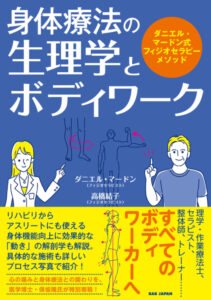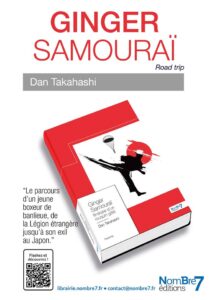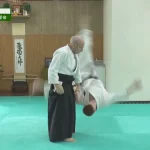【Exploring the spirit of the Ryukyu】Series 6 (HIDEN 10/2023)「Yagi Isao SENSEI」
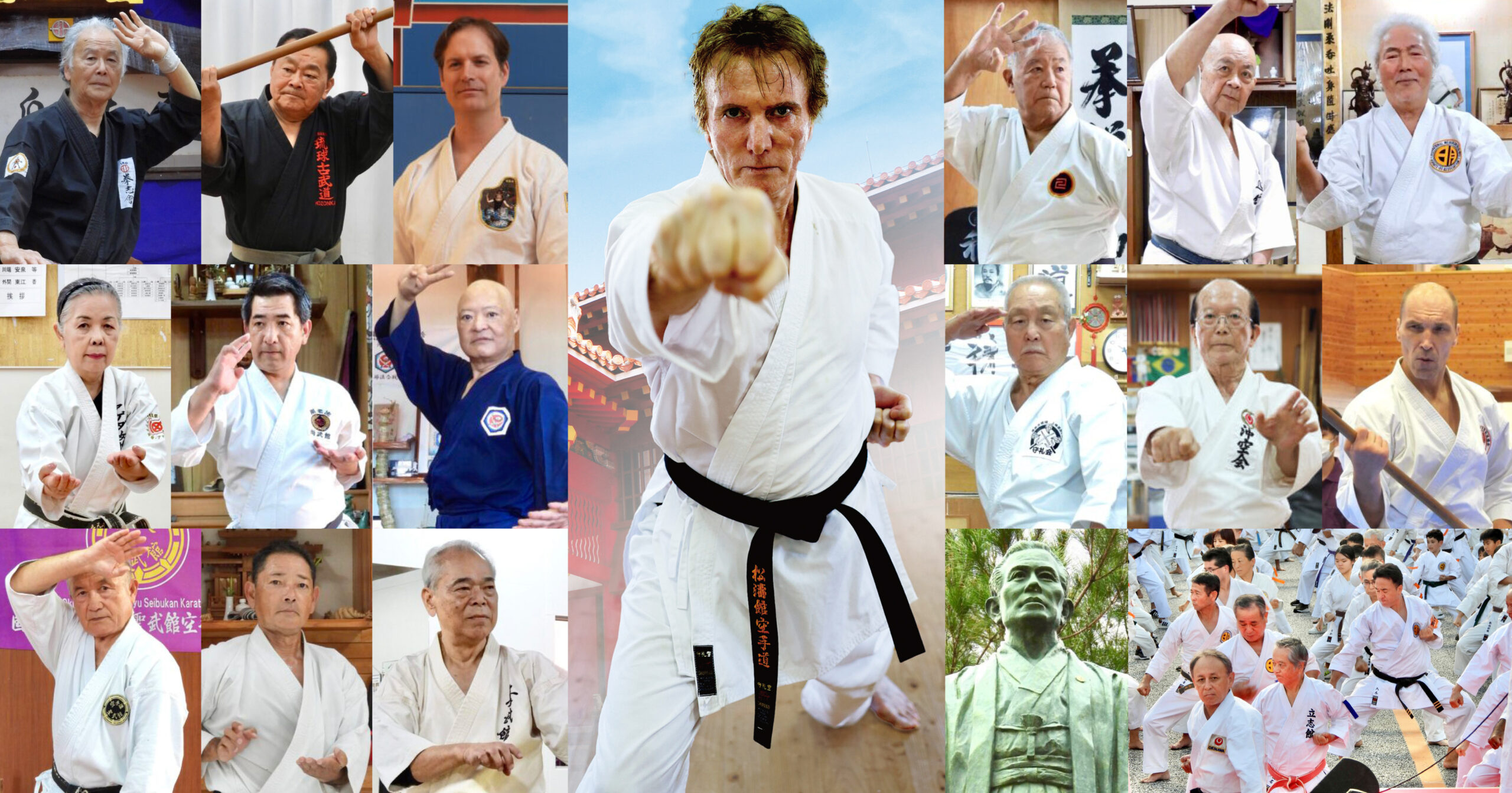
UDUNDI, the Karate of the Kings…
Moidi Motobu-ryu Gassen Tuidi kai Headquarters Dojo Yūsenkan
For several months, Daniel Mardon, the “Karateka-Therapist”, made it possible for us to discover the epic of Okinawan Karate through the visit of very special Dojo, Ryuha and Sensei. All these little gems have a very personal story which shows the complexity of accurately tracing the Karate saga. The Shuri-Te, Tomari-Te and Naha-Te still have many secrets to reveal…
If it is admitted that the Naha-Te comes from China, the Shuri-Te is considered the most “native” of the Ryukyu…
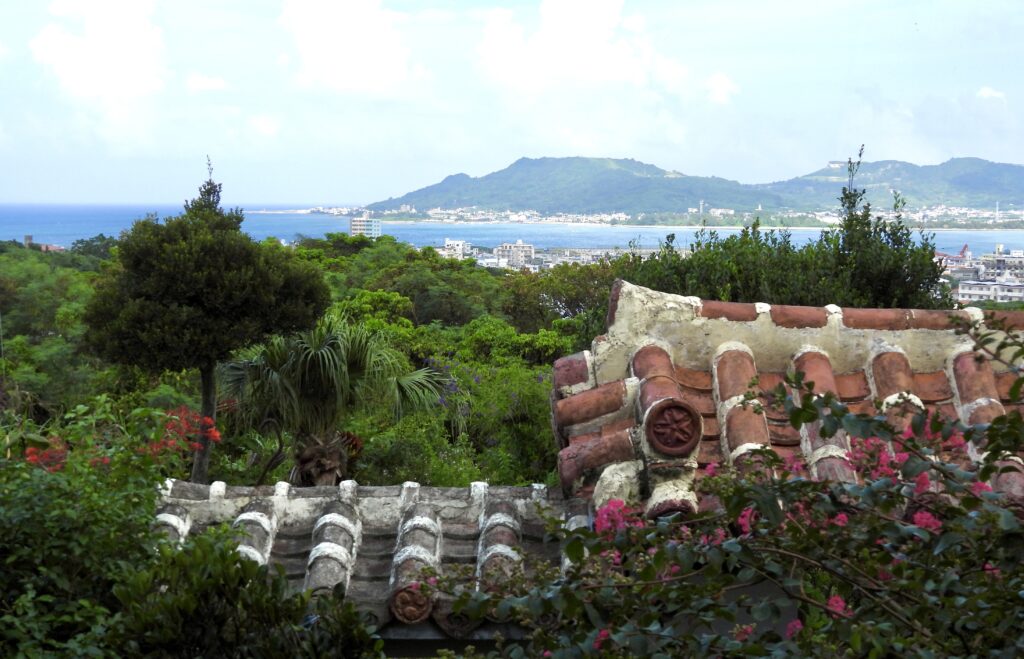
The view from the dojo is beautiful, with tropical trees, Ryukyu roof tiles, overlooking the Pacific ocean.
A few months ago, I met Hubert Laenen, a talented Belgian Karateka who said he was a 7th Dan in “Moidi Motobu-Ryu”. I had never heard about this version of Motobu-Ryu, but Hubert explained to me that it was the martial art taught to the body-guards of the royal family for more than 400 years. This unknown art remains mysterious, because it was only practiced within the palace walls; hence the name sometimes used; “Udundi” (hand of the royal palace). It was created by a branch of the royal family named Motobu and its ancestral transmission was only to the direct heir who was the eldest of the siblings.
The method is inspired by the “Moidi” (a centuries-old martial dance that gave rise to the foot-fist techniques), coupled with the “Tuidi” (projections) and perfected by a more military Kobudo which here includes weapons such as the sword. After some research, I understood why there was so much confusion between this art and the “Motobu-Ryu”; created by Motobu Choki (1870-1944) in 1922. Motobu Udundi was founded by Motobu Oji Chohei (1655-1687) 11 generations earlier…

The female dragon is rising into the blue sky…it’s so huge and real! Yagi Kancho (right) and Daniel sensei.

Posing in front of father dragon and mother dragon (back), the guardian deities of the Dojo.
Since Motobu Choki was the 3rd son, he did not have access to the family-art. His older brother; Motobu Choyu (1865-1928) was the one who was named 11th Soke and he was trained at the palace from the age of 6. Later, the two brothers learned together Shuri-Té with Itosu Anko and then Tomari-Te with Matsumora Kosaku.
So it was around the age of 52 that Motobu Choki created his “Motobu-Ryu” (which was rather called “Motobu-Kenpo”) and which is based on Shuri-Te and Tomari-Te…
Since all the sons of the 11th Soke had moved to Japan, it was difficult for them to practice and to take over. This is why the father Choyu Sensei decided to teach the secrets of Udundi to his best disciple; Seikichi Uehara (1904-2004).
Uehara Sensei, who had become the 12th Soke, decided to return the title and the secrets he had inherited to the family. Motobu Chomo, Choyu’s eldest son, was chosen to become the 13th Soke, but was killed in an air raid in Osaka in 1945.
It was in 1970 that Uehara Sensei revealed the existence of this secret art to the world and became recognized as the sole holder of “Motobu Udundi”. However, in 2003 when he had just turned 99, Uehara Sensei proposed that the succession should go to the Motobu family.
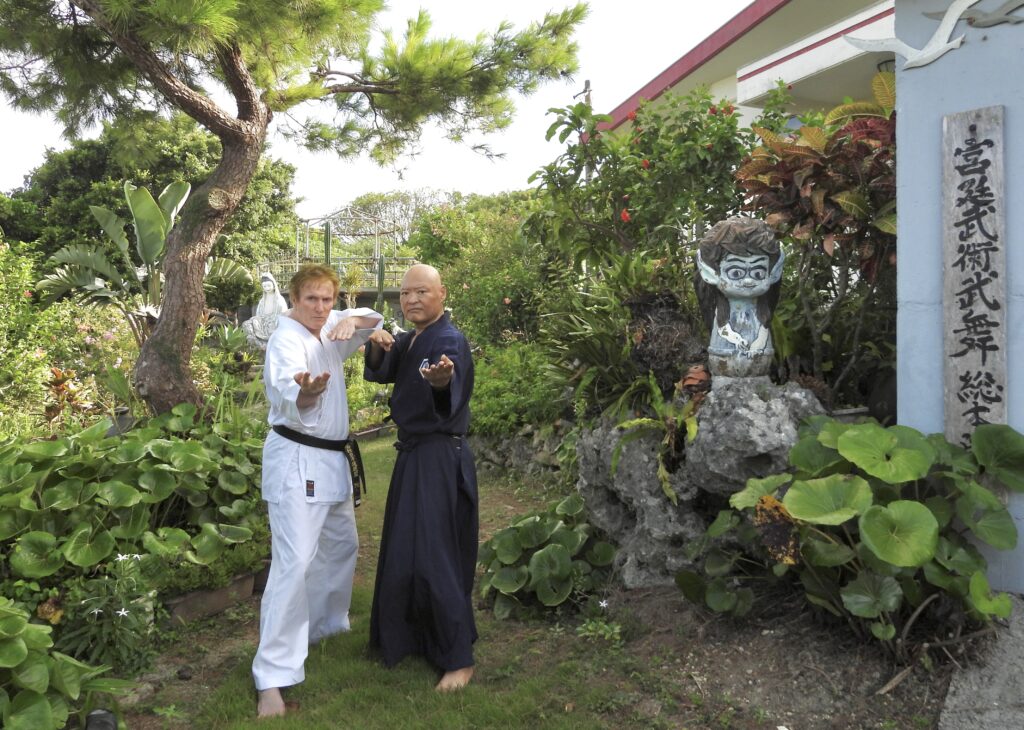
The Children dragon has for mission to protect the garden. A Kijimuna (spirit of the woods) greets us at the Dojo-entrance. In the background, behind the Ryukyu pine, stands Goddess Kannon.

Yuko Takahashi Sensei in the garden with Kannon 観音様.
Thus, Chosei, the 3rd son of Choki Sensei, who had already inherited the 日本傳流兵法本部拳法 (Motobu-Kenpo) from his father, found himself at the head of 2 styles by becoming the 14th Soke of Motobu Udundi.
Uehara Sensei had for 1st disciple Shiroma Seihan (1941-2012); a high school teacher. Shiroma had met him when he was 27 and had studied Udundi with him for many years. With the agreement of his Master, he had opened his own Dojo which he had named the “Moidi Motobu-ryu Gassen Tuidi kai”.
Years later, when Shiroma Sensei died, it was Yagi Isao Hanshi 9th Dan who became the Kancho of the superb Dojo in the mountains of Nanjo, south of Okinawa.
On arrival, 2 giant dragons built by Shiroma Sensei and his wife Hideko, guard the entrance of the Dojo and a 3rd is watching the back of the property. Their gaze is directed towards the East and the Pacific Ocean…
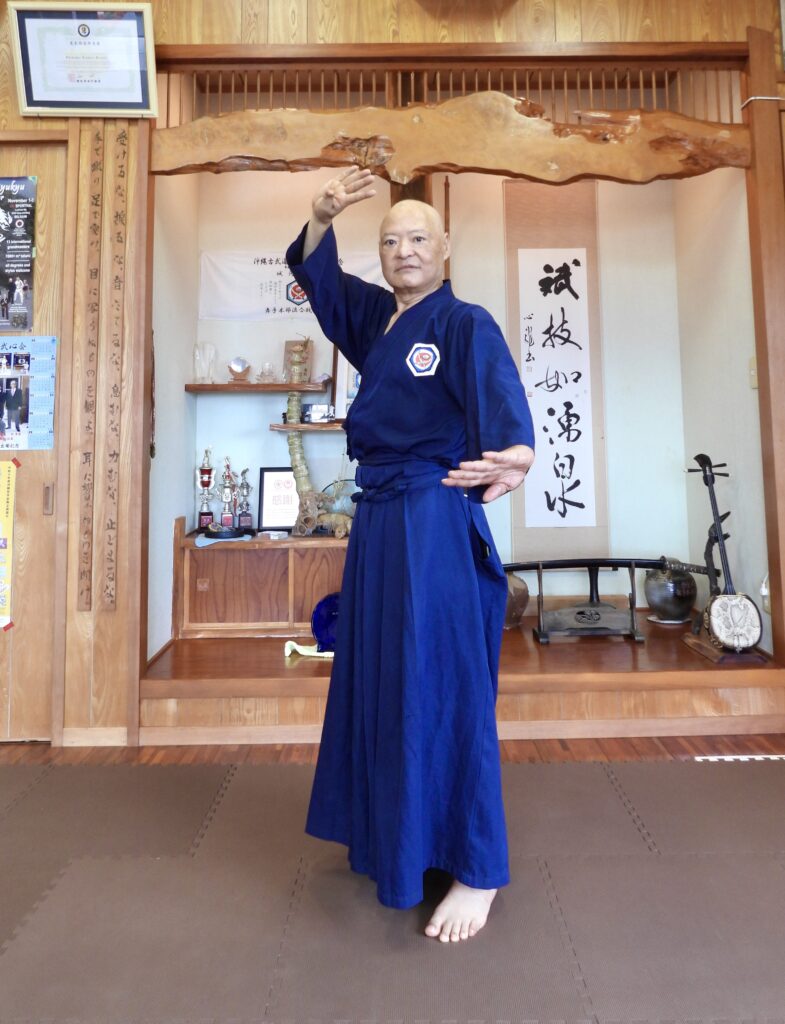
Biography of Yagi Isao
Chairman of Moidi Motobu-ryu Gassen Tuidi kai.
Hanshi 9th Dan.
Vice president of the Okinawa Prefecture Kobudo Renmei Federation. Standing Director of the Okinawa Prefecture Karatedo Rengo-kai.
Born in 1961 in Uruma City, Okinawa Prefecture.
At the age of 13 he started karate that he studied under Seikichi Odo Sensei of Okinawa Kempo and obtained his shodan (1st Dan). When he entered high school, he joined the karate club. and studied under Shiroma Seihan (President of the Moidi Motobu-ryu Gassen Tuidi kai). In 2012, after Shiroma Sensei passed away, he became the successor of the association and is still the president to this day.
Winner of the Open Shuri Cultural Festival karate competition “Kumite with individual armor”. Winner of the prefectural tournament and placed 5th in the national tournament (in 3rd year of high school).
In 1982 and 1983 he won for 2 years in a row the Open of the Shuri Cultural Festival karate competition “Kumite general men with individual armor”.
(1-) How did you start karate?
I had seen “Enter the Dragon” at the movie theater and I was impressed by Bruce Lee like many of my time. I had a friend in my neighborhood who had just started Karate and I told him that I also wanted to learn… He took me with him to his Dojo. It was Odo Seikichi Sensei’s “Okinawa Kempo Dojo” and I stayed there until my 1st Dan.
When I went to high school, I took classes at the Karate Club and its Director was Master Shiroma Seihan…. How lucky I was! I learned many Kata and practiced real combat with armor. I won the Okinawa Prefecture student championships, then obtained 5th place at the national level. Thanks to Shiroma Sensei for his teaching.
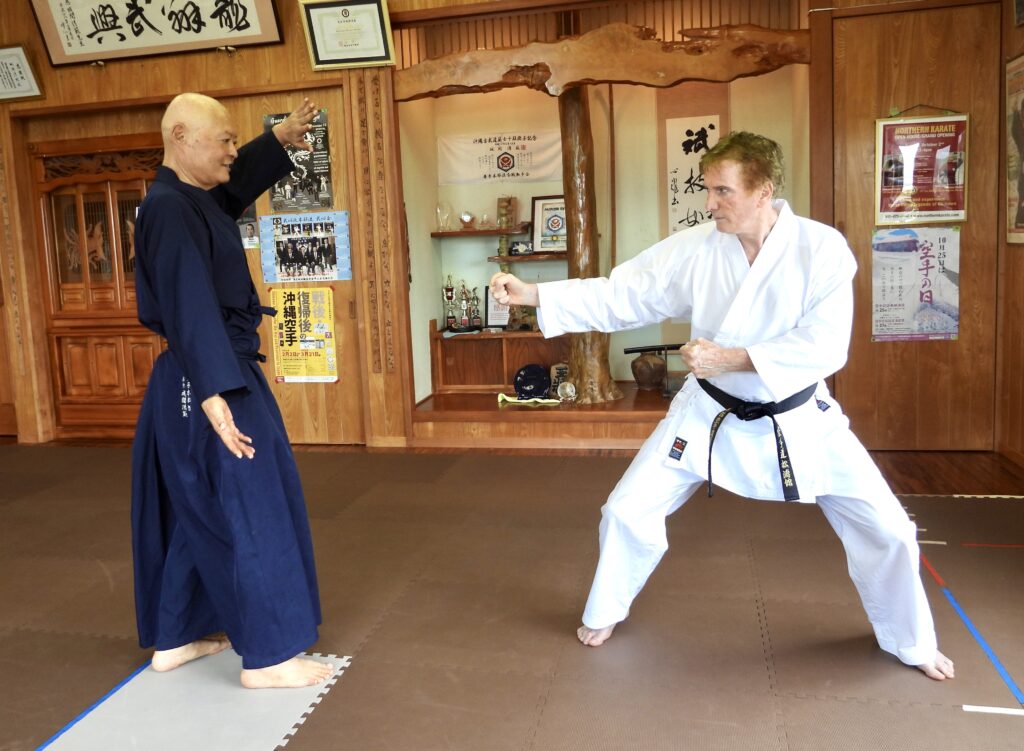
Yagi kancho is ready to avoid Daniel Sensei’s side kick (yoko geri)

Yagi Kancho dodging the Yoko-geri.
(2-) What are the characteristics of your school?
It is a very ancient martial art which descends from “Motobu Udundi”; a secret martial art of the Ryukyu royal family. It is therefore considered to belong to Shuri-Té, but is quite different. We use a wide variety of weapons and tactics that come from Kobudo and beyond. There are many “Ryuha” (styles) in Okinawan Karate, but “Motobu Udundi” is probably the oldest.
However, since it was only transmitted in the secrecy of the palace, it has only been discovered publicly 50 years ago. The name “Motobu Udundi” (本部御殿手) was created by Uehara Sensei in 1970.
(3-) What is your specialty?
The “Tuidi” (Torite in Japanese). The idea is to capture the opponent as unharmed as possible.
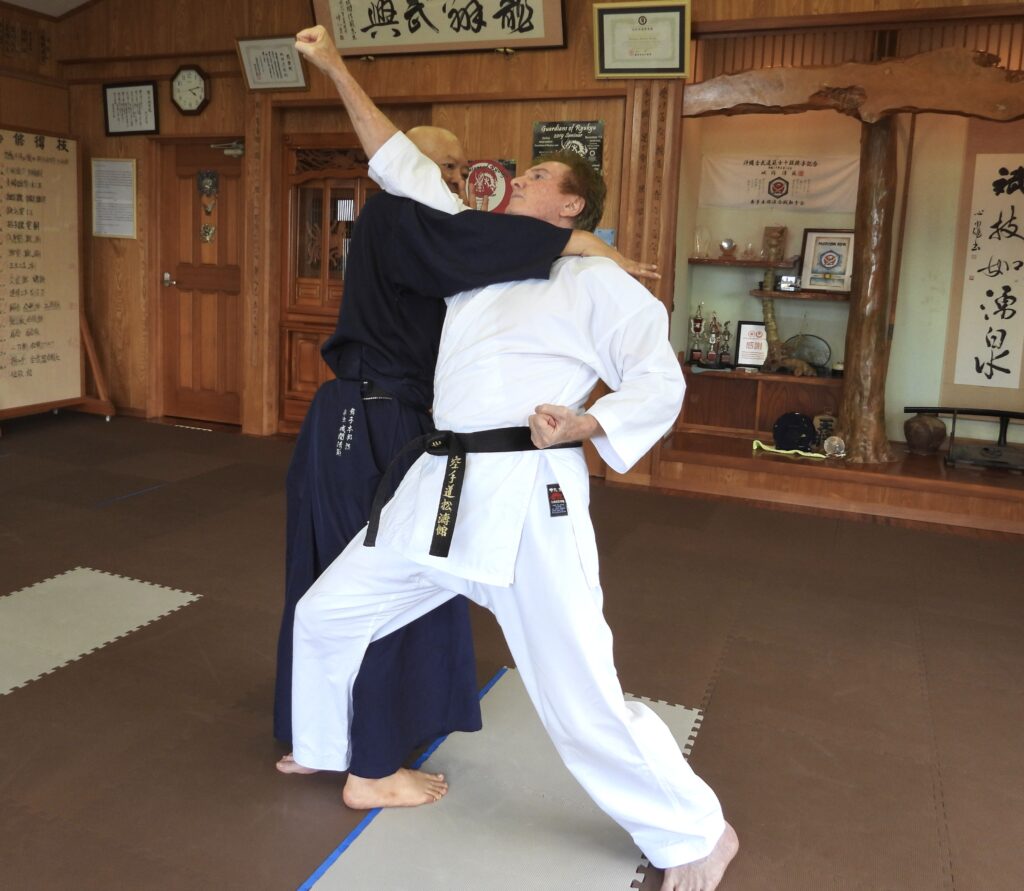
Tuidi (arm-lock) on right punch. (migi jyōdan oitsuki)
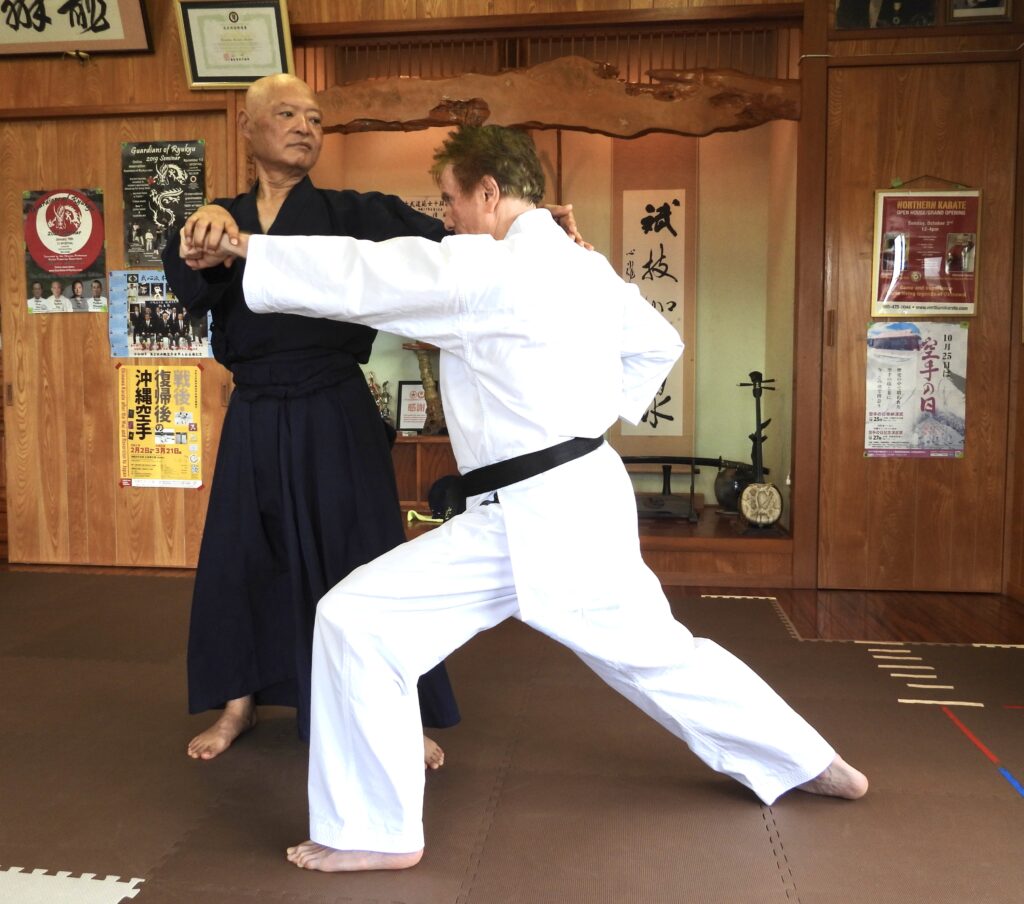
Tuidi on a left punch (hidari jyōdan oitsuki) with a strike on vital point.
(4-) What is the greatest memory of your “Shisho” (Master)?
Shiroma Sensei died of illness 11 years ago, but during his long struggle, he never complained in front of his disciples and always kept a calm and serene face. I thought this Master was a real “武人bujin/warrior” until the end. He said: “If you practice the state of calm, you will always be able to remain relaxed even in an emergency and regardless of the attacks of your environment. You can develop it through the practice of martial arts, he repeated. I have very deep memories of my Master’s life…
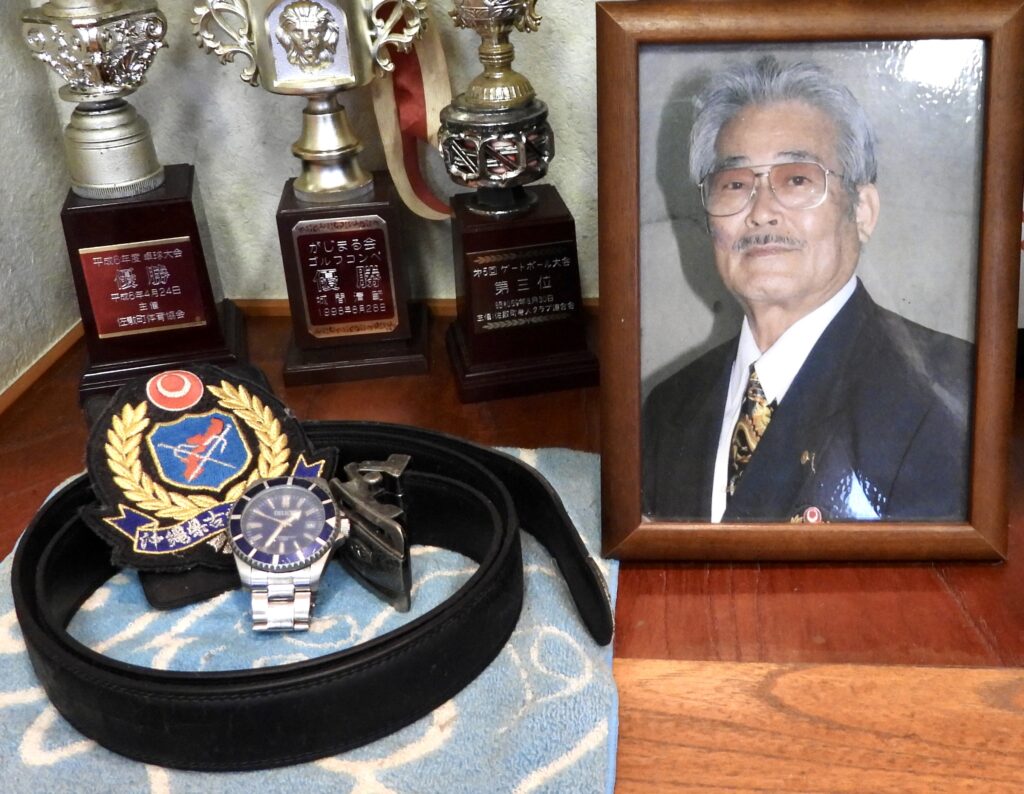
Memorial with personal effects belonging to Shiroma Sensei. His photo looks like he is watching on the Dojo.
(5-) What is the difference between Okinawan Karate and Japanese Karate?
I often hear from Karate teachers here that Japanese Karate has become more competitive. I agree. In Okinawa, we value traditions and we appreciate the teaching of Kata which comes to us from ancient times. But we also really appreciate “Kumite-jutsu” which has always been taught to us.
(6-) Do you teach foreigners a lot?
We now have representatives abroad and we ensure the continuity of their teaching each year. During the last 3 years we had to postpone because of Covid, but we reopened.
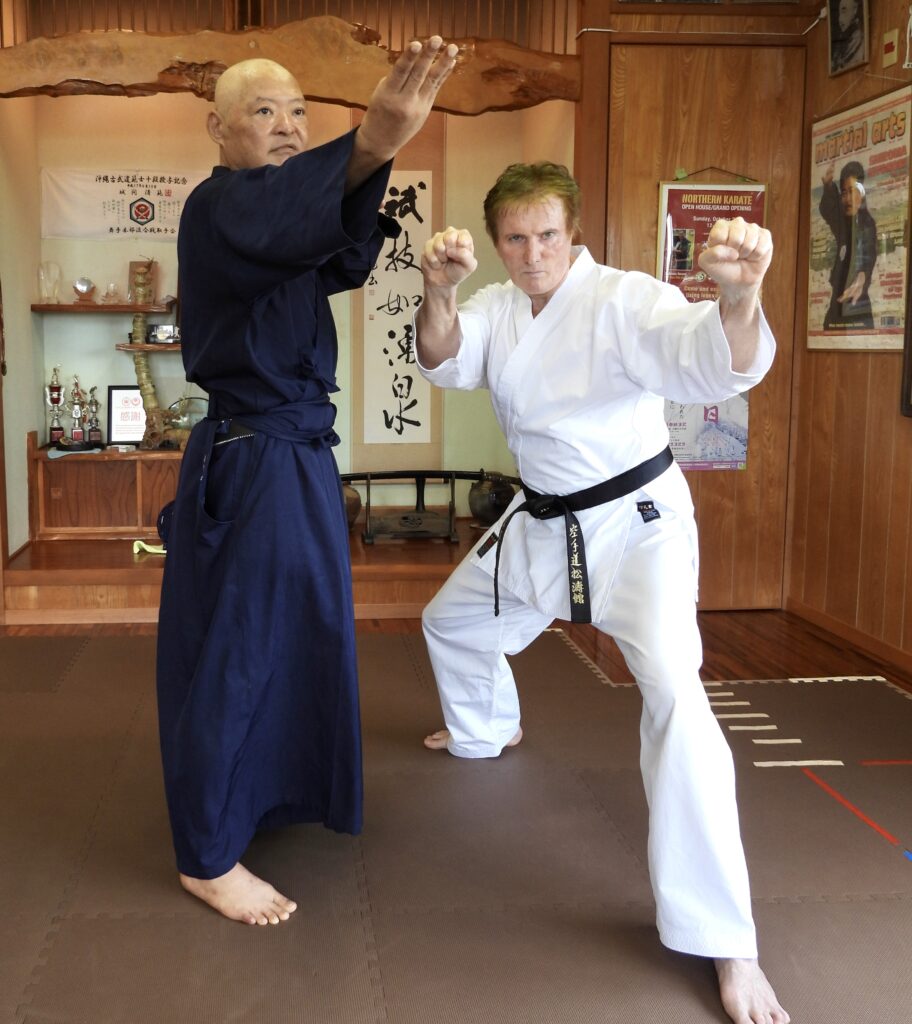
Two different positions from two different styles. Yagi kancho is doing a Moidi Motobu-style nukite, and Daniel-sensei a Shotokan-style double uchiuke.
(7-) What do you think about the globalization of Karate?
Since I am a native of the Ryukyu and from the source of Karate, I am happy that Okinawan Karate is impacting the world. It must be understood that although we had a unified kingdom from 1429 to 1879, we had always lived in territories under monarchy. I believe it was the same for you in France… Our small territories prospered thanks to trade with the great Chinese power under the Ming and Qing dynasties. However, from 1609 the Ryukyu were under the control of the Japanese Satsuma clan (薩摩藩 Satsuma han) and had to pay them an annual tax. Okinawa then served as a battlefield during the 2nd World War and we lost a third of our population to end up under full control of the USA… After having been so badly mistreated and suffering so much submission, I hope that our Karate will get us out of this disgrace and will bring peace to the world…
(8-) What do you think of Karate which is turning more and more towards competition and even the Olympics?
Indeed, Karate is becoming more and more competitive and the Kata seem to have been rebuilt on different bases including the tempo (間合い/まあい/maai), the Kime (極め/きめ/pose and pause), the sound (hammering feet, clicking Do-Gi), etc.
Kata should not be embellished with harmonious movements (tameru 溜める/ためる). What’s the point of all this? There are several of us in Okinawa who have this point of view and if “Moidi Motobu-Ryu” could spread, that would be good.

Yagi kancho teaches the basic movements of keri( kicking). It is said that the first thing you learn in the Moidi Motobu ryu is walking techniques, thrusting and kicking.
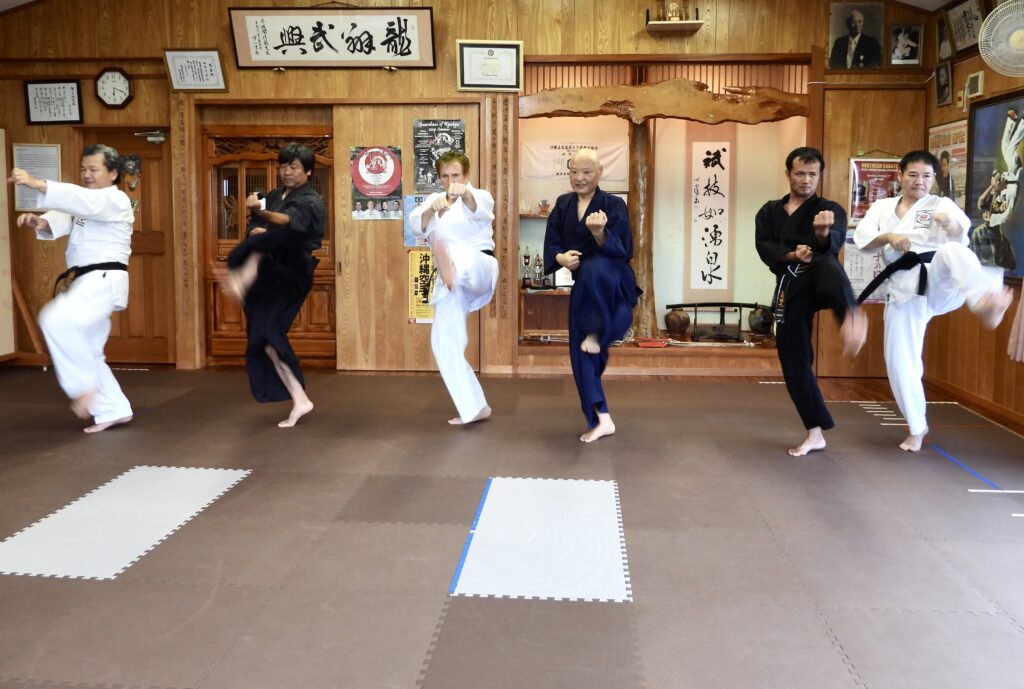
Kicking practice. Daniel Sensei in practice along with his disciples.

Punching practice with the characteristic stance.
(9-) What does today’s Karate mean to you?
Sadly, wars and conflicts still persist in the 21st century! It is therefore important to learn to defend yourself…
(10-) How do you see the future of Karate?
Currently, the world of Okinawan Karate is working towards achieving global recognition of its cultural heritage through UNESCO. I want to be part of this transition to our future generations.
(11-) Do you have a message to send to the world?
Broaden your horizons by coming to learn our Karate at its source here in Okinawa…
(12-) What does the label “Karate” mean to you?
Training “心技体”Shingitai to support life.
Note: This has became a very fashionable word grouping together: shin心(kokoro)gi技(waza) tai体(karada). Mind-technique-body.

Some members of the Yusenkan Dojo and Shiroma sensei’s wife, Hideko, holding a photo of her husband. 3rd from the left, Yuko Sensei, our photographer, writer and translator.
—— Conclusion by Daniel Sensei
This interview took me back in time. The Moidi Motobu-ryu made me travel far beyond China and Japan…. The use of weapons took me on a journey along the “Silk Road”. The danse-like rotations of the body reminded me of the “whirling Dervishes” of Turkey and Persia. Also the metallic reflections of the swords projected sent flashes towards India.
Bodhidharma would also deserve his photo here…
Finally, this martial art is the most complete that I have ever practiced. Certain techniques seem to be related to the “Zorkaneh” of Uzbekistan and the “en garde” postures and kicks strangely resemble our ancestral French “Savate”… A journey across the world that would end in Okinawa?

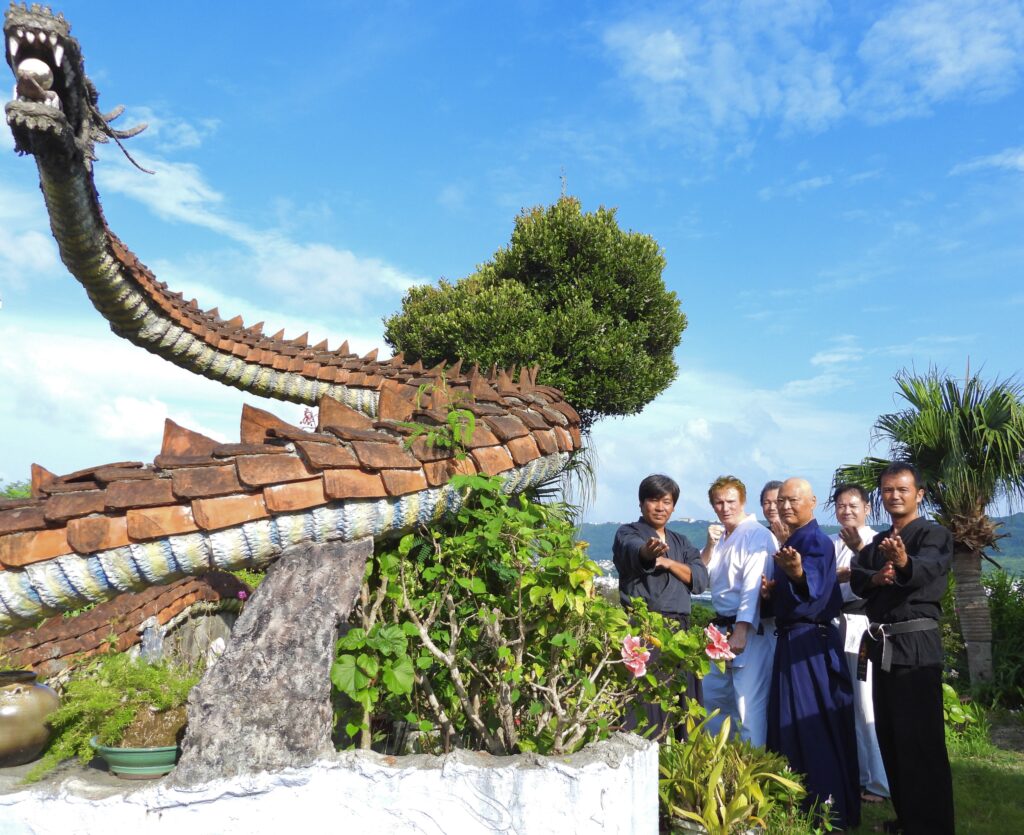
Posing near the dragon.
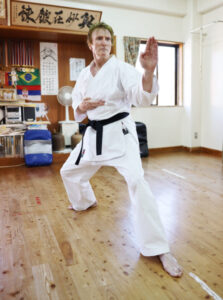
Daniel Mardon; the Karateka-Therapist
Creator of Aromapressure® method and physiotherapist with a valid US license, Daniel Mardon was born in Paris. One of his specialties is to teach and to perform lymphedema and subcutaneous tissue-damage care, after radiotherapy for cancer patients at medical institutions and subcutaneous tissue-circulation stimulation before and after surgery.
He was also a therapist for two famous soccer teams in Paris. Since 2005, he has focused on producing top-class hotel spas in Japan, as well as physiotherapy education and awareness-raising activities for health care professionals. Author of several books, among his major publications includes “The Physiology and Bodywork of Physical Therapy ” (Published by BAB Japan) and DVD “Daniel Mardon Aromapressure® Method ” (Pony Canyon). He regularly appears on television and radio shows, and has featured in numerous media publications.

